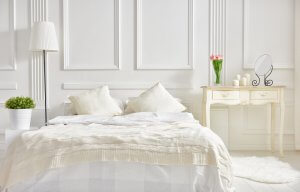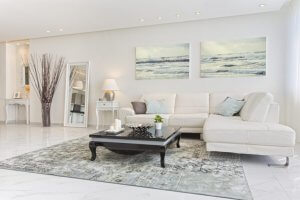Why Does White Go Well With Everything?

When it comes to decorating our homes, we often start by trying to devise the perfect color palette. There is a huge range of colors to choose from, and not all of them work in harmony with one another. With one exception – white. But why is it that it goes so well with pretty much everything?
It’s not by chance or lack of imagination that white is one of the most popular colors in interior design. It has always been considered one of the best options for homes and is easy to combine with almost any color. What’s more, it can also work well in any style of home.
Simple and understated, it’s easy to underestimate its importance. After all, when was the last time you heard someone say white was their favorite color? However, within the world of interior design, it takes on a greater level of relevance and meaning, opening up a whole array of new possibilities.
The psychology of color

White can convey a unique array of feelings and sensations. Its presence in interior decor has long been associated with:
- Cleanliness and purity – this color is often linked with tasks and environments where hygiene is essential. As any stains instantly show up on lighter surfaces, pure white walls and floors transmit feelings of unparalleled cleanliness.
- Brightness – this color has the unique ability to reflect the light away from surfaces. This means that it can help illuminate even the gloomiest of rooms.
- Freshness – it’s often associated with winter, reminding us of snow and ice. As a result, it can help bring a breath of fresh air to our homes.
- Peace and calm – its neutral aesthetic conveys feelings of serenity and tranquillity.
Shades of white

In reality, white isn’t a color at all. Technically speaking, it’s the total absence of color. However, it’s become an indispensable tool in the world of interior decor, and there’s a wide variety of different shades to choose from. Some of the most important include:
- Pure white – as the name suggests, this is its purest form, with no additional tints or hues.
- Off-white or natural white – this is the next closest to pure white. It has a slightly more muted character, allowing you to maintain that feeling of brightness in the room while bringing an added sense of warmth.
- Snow white – this shade has the opposite effect to off-white. It tends to have a slightly gray or bluish tinge to it, bringing to mind the image of ice or snow
- Pearl – like snow white, pearl also has a cold, bluish tint to it. It’s often used on satin textiles, such as silk.
- Bone or marble – this shade has a yellowish hue. It’s perfect for classical-style rooms and even combines well with vintage decor.
Where can you use white in your decor?

When it comes to interior design, white is a classic. As we’ve already seen, the sensations it conveys can help you transform your home into a much more pleasant and welcoming space.
While you can use this color on all kinds of different surfaces, it’s mainly used for painting the walls. It’s a common feature in many homes, especially in those where the designer was looking to increase the overall brightness. It’s highly recommended for rooms that don’t receive enough natural light.
Another interesting way to incorporate this color into your decor is to use it to paint the exterior walls. This will give your home a breath of fresh air, reminiscent of the Mediterranean style.
Alternatively, you could opt for white furniture such as sofas or armchairs. This is an effective and simple way to achieve a sense of peace and harmony.
Textiles

This can be somewhat risky, as fabrics and upholstery can easily get dirty and stained over time, spoiling the overall aesthetic. However, with proper care, they can help you to create a light, fresh environment.
Some of the best options include carpets, bedspreads, curtains, sofa covers, cushions, and wall hangings.
Don’t hesitate to incorporate white elements into your decor, and give your home a sense of character. This charming aesthetic can help to brighten any environment, conveying feelings of harmony and purity.
All cited sources were thoroughly reviewed by our team to ensure their quality, reliability, currency, and validity. The bibliography of this article was considered reliable and of academic or scientific accuracy.
Lluch, Francisco Javier: Arte de armonizar colores, Barcelona, Imprensa El Porvenir, 1858.